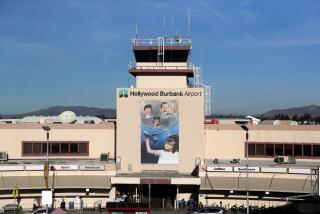Burbank Airport Outlines 21 Noise Reduction Options
- Share via
Burbank airport officials have unveiled a host of proposals to ease the aircraft noise problems of nearby residents, ranging from runway sound barriers to the curfews and flight caps being sought by the city of Burbank.
Using computer modeling, consultants for the Burbank-Glendale-Pasadena Airport Authority outlined 21 options with the potential to reduce noise in and around the airport. However, the study released this week seems to conclude that only about seven of the recommendations deserve serious consideration, and it’s an open question as to whether any will be implemented.
The Part 150 study, named for a federal aviation regulation under which airports are given federal grants to study local noise problems, is part of a larger report to be submitted by airport officials to the federal government later this year.
The report looks at the growth in commercial and private aviation, potential effects on neighborhoods surrounding the airport and possible mitigation measures. That does not mean the measures will be put into effect, said airport spokesman Sean McCarthy.
“It’s too early to tell what we’re going to do,” McCarthy said. “But we will look at the recommendations and consider the technical feasibility, the financial realities and the legal requirements.”
The airport scored a minor victory this week in a separate state action when the California Department of Transportation renewed its “variance”-- a permit to continue operating without meeting all state noise control ordinances. Most of the major commercial airports in the state operate under such permits, which must be renewed every three years.
In its report on noise abatement alternatives in the Part 150 study, Missouri-based Coffman Associates Inc. suggests a half-dozen ways to reduce aircraft noise, including a 20-foot-high noise wall on the east side of the airport, enclosures to deflect noise during engine run-ups, encouraging pilots of noisier Stage II and Stage III corporate aircraft to use quiet flying procedures, moving night flights over less dense residential areas, and a prohibition on nighttime takeoffs.
The draft report comes on the heels of data released this week indicating that the number of airline travelers at Burbank Airport would double from 4.7 million now to more than 10 million by 2020. Airport officials said that would occur no matter what the airport does about expanding its terminal, the focus of its bitter dispute with the city of Burbank.
Over that same period, the number of homes impacted by more flights would increase 20%--or about 438 residences--if no steps were taken to address the issue, the report said. Now, 2,184 homes are classified by a complicated system as “impacted” by aircraft noise, according to the airport.
*
Burbank officials, who have been warring with the airport for years over noise issues, said the data in this week’s reports constituted proof that the airport’s noise problem is getting worse, supporting their long-held demands for a limit on the number of flights and a ban on most takeoffs between 10 p.m. and 7 a.m.
“The airport authority has been arguing the airport is getting quieter,” said Peter Kirsch, an attorney representing Burbank on airport issues. “While that was true at one point, it hasn’t been true for the last several years.”
Kirsch said the city will continue to resist the airport’s plans to build a 19-gate terminal on 130 acres of land owned by Lockheed-Martin Corp.
“We intend to use whatever tools are available to limit the growth of the airport facility,” he added. “We also have been pressuring the airport authority to use tools at its disposal to limit noise impact, which they are not doing.”
Thus far, that pressure has come largely in court, where Burbank has waged an expensive battle to block the terminal project.
In February, a Los Angeles Superior Court judge ruled that Burbank could not use local land-use ordinances to block construction, holding that the city had relinquished that right by signing a joint powers agreement to run the airport with the cities of Glendale and Pasadena.
Burbank followed that up with a lawsuit in May by charging that the airport authority violated the city’s zoning codes by planning to build the terminal on land zoned for manufacturing without consulting city leaders. Another judge will rule in that case before the end of the year.
Airport officials say the noise issue must be considered separately from the terminal project.
More to Read
Sign up for Essential California
The most important California stories and recommendations in your inbox every morning.
You may occasionally receive promotional content from the Los Angeles Times.













